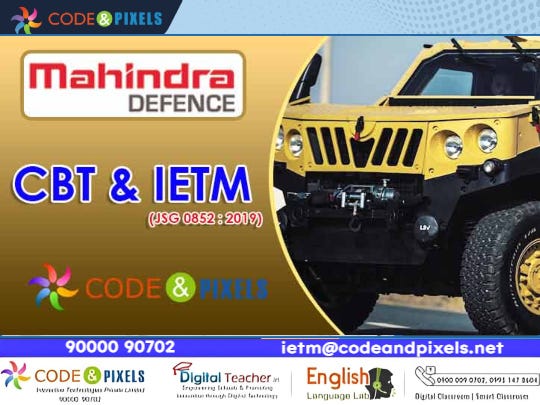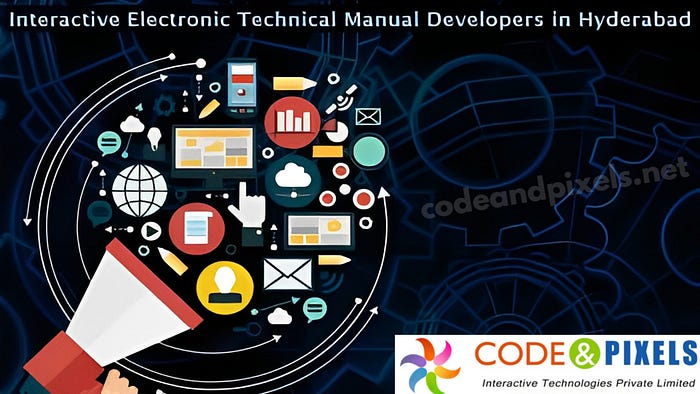Exploring the Different Levels of IETM and CBT
Understanding the Different Levels of IETM and CBT, their unique purposes, multimedia components, cost calculations, and the importance of clarity in AR/VR. Unveiling the confusion and enhancing learning!”
Let’s explore the fascinating world of computer-based training (CBT) and interactive electronic technical manuals (IETM). You ask, which one is better. You might be surprised by my response, but it’s similar to comparing apples and oranges or asking whether a fan is superior to a tube light. They have many functions and each has value in its own right.

Image Source: ( Google — Code And Pixels )
Understanding Their Unique Purposes: IETM and CBT
Imagine yourself perspiring on a scorching summer day and in dire need of some refreshing air. A tube light might be useful. Obviously not! You can’t directly compare IETM with CBT, just as you can’t substitute the comforting air of a fan for the illumination of a light bulb. In their respective fields, they are exceptional and irreplaceable.
Let me simplify things for you. IETM is the collective name for a user-friendly collection of technical publications, PDFs, and manuals. It’s like having all of your information conveniently located and organised. The days of turning endless pages or scrolling endlessly through PDFs are over. Utilising search features, hyperlinks, hot spots, related topics, or menu options, IETM allows you to find what you’re looking for in a matter of seconds.
Exploring the Different Levels of CBT and Their Multimedia Components:
On the other hand, we have CBT, which stands for Computer-based Training. It’s all about providing detailed explanations through multimedia elements like animations, videos, and voice-overs. Imagine having a step-by-step guide with a friendly voice explaining complex processes, assembly or disassembly procedures, or operating instructions. CBT focuses on essential topics that require real-time practice or visual demonstrations. It’s like having a knowledgeable instructor right at your fingertips.
But here’s the catch — CBT doesn’t cover the entire system. It zooms in on the critical aspects that demand hands-on training, such as operating procedures or installation processes. Creating a CBT for a ship, for instance, could take up to 2000 hours and a substantial investment. However, when a problem arises, it’s not practical to spend hours searching through a lengthy CBT. That’s where the trusty IETM comes to the rescue!
In fact, about 90% of issues can be resolved by referring to the comprehensive manuals provided in the IETM. Only about 10% of problems require the expertise of an expert advisor. So, you see, both IETM and CBT have their unique roles to play, and they complement each other beautifully.
Let’s have a fun adventure across the IETM and CBT worlds! Every one of them has a distinct purpose, yet occasionally people mix them up in odd ways. It just doesn’t work to try to combine a unicorn and a dragon.
Level 5: Improving IETM with Design:
There are various levels within the CBTs. Less animations are present in Level 1 whereas more animations and images are present in Level 2. And if you reach Level 3 or 4, get ready for even more interactivity and fancy 3D and mode graphics. But here’s the thing, my friend — just because you add some animations and 3D elements to an IETM, it doesn’t magically transform into a Level 5 IETM. Nope, it’s still just a Level 4 IETM, albeit with some snazzy 2D animations, 3D animations, and videos in the form of MP4s. If your animations are in HTML-5, you can even add hyperlinks and open your CBT in a separate tab or window in your browser.
Now, brace yourself for this mind-blowing revelation! I stumbled upon a recent document where they added some content and called it Level 5. But wait, there’s more — they also tossed in some AR and VR and labeled it Level 6. Talk about taking things to the next level! AR, VR, e-learning, CBTs, and video films are all multimedia components that enhance the user experience and are undoubtedly crucial for effective learning. But here’s the catch — mixing IETM and CBT and inflating the levels goes beyond the boundaries of the JSG-0852–2019 document. It’s like trying to fit an elephant into a teacup!

Cost Calculations and Clarity:
Let’s get one thing straight — adding AR/VR/3D/2D/videos doesn’t magically elevate the IETM level. CBT and IETM video films are like peas in a pod when it comes to training. They’re separate deliverables developed for different purposes. So, when it comes to costs, IETM calculations depend on the number of pages, let’s say around 200 rupees per page. On the other hand, CBT costs are determined by the number of hours and whether it’s 2D or 3D. Let’s assume around 2 lakhs per hour. As for AR and , well, they have their own universe and category. Implementing AR and VR can cost anywhere from 1 crore to 2 crores! That’s no small change, my friend.
So, when you’re floating that RFP (Request for Proposal), make sure to be specific. How many pages are we talking about? If you want to include 2D or 3D animations, what’s the duration for each? And most importantly, please don’t mix up AR and VR with IETM. They’re like two parallel dimensions that should never meet.
Adventures with IETM and CBT:
So, next time someone asks you which is better, IETM or CBT, you can confidently say, “Well, it’s like comparing a fan to a tube light! They have different purposes, and we need them both to shine bright and keep things cool in the world of technical knowledge.”
The Project Manager of IETM at Code and Pixels brought you this amusing article. Many thanks for reading.!!!
Comments
Post a Comment